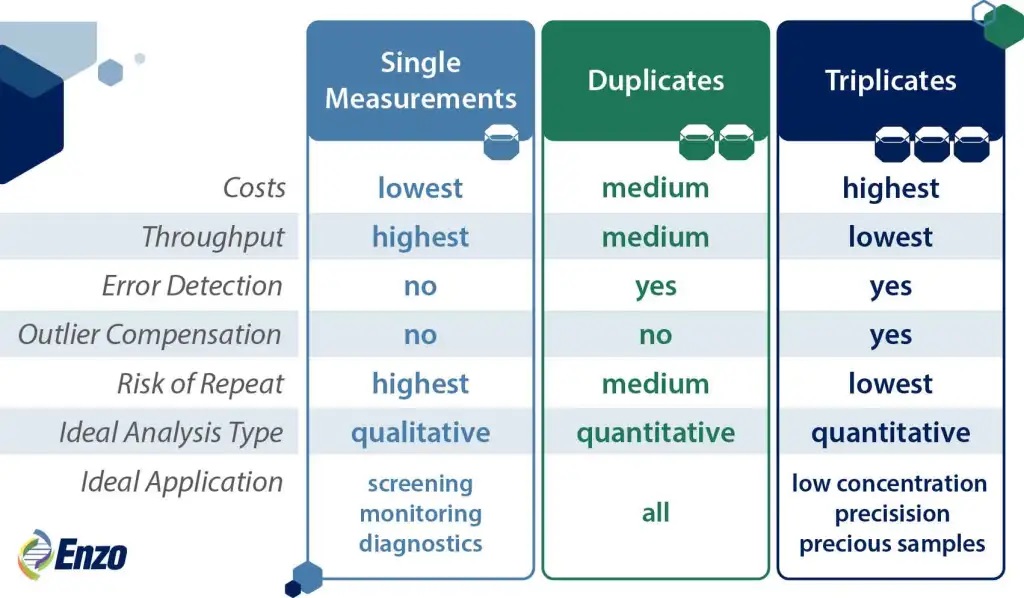Replicates in ELISA
When to use Triplicates, Duplicates, or Single Measurements
Our partner Enzo Life Sciences is a life sciences and biotechnology company, focusing on harnessing biological process to develop research tools, diagnostics and therapeutics, and serves as a provider of test services, including exotic tests, to the medical community.
With comprehensive expertise in experimental settings, Enzo' Senior Application Scientist Dr. Hartmut Pohl provides detailed advise on how often an ELISA measurement should be repeated.
Various Forms of Replicates
Experimental science relies on replicate measurements and their statistical analysis. But how should experiments be repeated and how often? The first step to obtain an answer to this question is understanding the difference between biological and technical replicates.
Biological replicates are distinct samples from different biological specimens, e.g., blood samples from various individual patients – to provide an example of a clear-cut case of biological replicates.
Technical replicates, or repeats on the other hand are repetitions of the technical, experimental procedure, meaning running the same test multiple times with the same biological sample.
Biological replicates form the bedrock of sound statistical analysis to control for natural variability. Technical replicates serve to determine and control for the variability of the method itself. Whether they are helpful or necessary depends as much on the method as on the study design, and on the availability of biological samples and general resources. In some scenarios it might be beneficial to control tightly for method variability, while in other settings it might be better to just measure a large enough number of biological samples once, and account for the technical variability as part of the overall data fluctuation. Ideally, a detailed statistical power analysis is performed as part of the experimental planning to determine how many and which kind of replicates are required.
Replicates in ELISA
This principle naturally applies to enzyme-linked immunosorbent assays (ELISA). ELISA is a well-used laboratory technique that may or may not benefit from technical replicates, depending on the specific application and intended use. The necessity and value of technical replicates can vary greatly between diagnostic and research applications, and the overall scope of the analysis. Needless to say, reducing replicates can offer significant cost savings – which are quickly eaten up, if measurements need to be repeated. Whether to use technical replicates or not, meaning whether single wells, duplicates, or triplicates are being measured for any given sample ultimately depends on the end users’ preferences, the question the test is meant to answer, and finally the individual choice in regards of balancing efficiency with data accuracy.
Let’s have a look at the pros and cons for individual measurements, duplicates, and triplicates to help to decide which one may be preferable for a given assay:
Single Measurements
Individual measurements with one well per sample allow to maximize resources and measure as many samples as possible with a given assay. Single well measurements are generally used when high throughput is more important than data variability, and are particularly useful, when the goal is semi-quantitative or qualitative analysis. Especially qualitative ELISA assays that provide a test result as positive or negative, but do not provide a value for each sample, are frequently used in conjunction with single well measurements. These types of analyses are often rooted on a solid basis of expected value ranges for a typical sample and rely on retesting criteria to analyze outliers.
Furthermore, single measurements may suffice for study designs with recurrent measurements of samples from an individual biological source, for example with time-course experiments, where samples are taken at intervals from a given specimen and measured. In these settings, outliers can be identified in respect to the other samples of the same origin.
Finally, single measurements might be sufficient in high-throughput applications, where testing a large number of samples is more important than certainty on the individual sample. Additionally, the discrepancies between samples in regards to the measured value may be very high. This is regularly the case for ELISA applications in quality control of biological manufacturing.
Error analysis and correction: It is impossible to identify outliers and erroneous data points with single well measurements. Measurements that were faulty can therefore not be clearly identified or corrected and will go unnoticed.
It is therefore crucial to be aware that the obtained data set will contain a certain margin of error. For qualitative ELISA assay, the compensating strategy is often to build a generous margin of error into the analysis and have cutoff values for determining negative and positive samples that are well below or above the real cutoff value, and label any result as “uncertain”, “retest” or similar for values that fall within the set margin of error of the real cutoff value. These tests typically rely on clear expectations in regards to the value ranges the tested samples should fall into. For certified diagnostic tests, these values have been determined through clinical studies that form the basis of the certification.
If the assay is quantitative, then single-well analysis should only be used, if the goal is to analyze the mean values of groups of samples and the cohorts are large enough that individual procedural errors do not compromise the subsequent analysis. Single well quantitative measurements are not recommended for the quantification of individual samples.
Note: Single-well measurements certainly have merit and can be highly useful, if in line with the intended analysis. However, it is generally advisable to perform the essential controls and standards in duplicates. While the consequence of single measurements analysis of samples is that individual procedural errors may go unnoticed and thus single samples might be erroneous, unnoticed deviations or errors in the controls or standards will lead to an overall error throughout all obtained data and a misinterpretation of all results. Thus, measuring standards and essential controls in single wells should be avoided.
It is generally not advisable to use single well measurements per sample, unless the consequences of potentially undetected measurement errors have been well considered and are compensated by the assay design, experimental design, and/or result analysis.

Table: Pros and cons of the amounts of replicates per sample in ELISA analysis.
Duplicate Measurements
Duplicate measurements are generally the sweet spot for ELISA analysis and an ideal compromise between error management and high-throughput capacity. Duplicates enable a certain level of error compensation by calculating a mean value out of two measurements, increasing the likelihood of measuring closer to the real value. Enzo recommends duplicate measurements for the vast majority of our ELISA kits.
Error Analysis and correction: Measuring each sample in two individually pipetted wells allows to identify errors and outliers, but does not allow to compensate for it. Measurement deviations can be identified, e.g., by calculating variabilities as %CV or standard deviation. A threshold criterion can be defined at which variability between the two measurements is considered too high to use. Commonly, %CV greater than 15-20% are used, but the choice of threshold may change depending on individual preference and experimental or analytical requirements. Samples exceeding the set threshold should be disregarded for analysis and re-measured, if possible. It is not recommended to discard individual measurements in a pair of duplicates and perform the analysis with the remaining single measurement value. While it may sometimes seem obvious which well is the problematic one, there is no systematic way to identifying the faulty measurement amongst two duplicates with certainty. There may be exceptions, like remembering that one forgot to pipet a component into that very well, but generally, analysis should be performed either based on both duplicates, or the entire sample should be excluded from analysis (and repeated, if possible).
Triplicate Measurements
Triplicate measurements allow a significantly greater control of and compensation for errors. The mean calculated from triplicate measurements is significantly more likely to represent the true value of a sample’s analyte concentration. Thus, the use of triplicates is indicated when data precision is paramount. However, it comes at the cost of a significant reduction in throughput capacity and reagent use efficiency.
Error Analysis and correction: Triplicate measurements allow not only to identify erroneous measurements, but allow to correct for them as well. By identifying outliers, individual measurements can be excluded and the sample can be quantified based on the remaining two of three triplicates. However, outlier identification and exclusion should be performed based on hard, predefined criteria. Samples with high variability should be identified, e.g., based on %CV, standard deviation, multiples of sigma, or other methods. Outliers within these samples should be identified by deviation from the mean of the three replicates. Outliers above a predefined threshold can be disregarded and the value may be calculated based on two of the three triplicates. If no outlier can be identified, or if the overall variability between all three technical replicates is too high, the entire sample may be disregarded and remeasured, if possible.
Summary
- Choosing the right number of technical replicates in ELISA is key for balancing resource efficiency with data quality.
- Single measurements are efficient for high-throughput or qualitative ELISAs but don’t allow error detection, making them unsuitable for precise quantification.
- Duplicates offer a good balance of accuracy and efficiency, enabling error detection but not correction—retesting is needed if variability is too high.
- Triplicates provide the highest accuracy, allowing for outlier removal and correction, but reduce throughput and use more resources.
- The choice depends on the set of goals, acceptable error levels, and resource availability.
Source: Enzo Technologies, Tech. Note "When to use Triplicates, Duplicates, or Single Measurements in ELISA – And Why"


